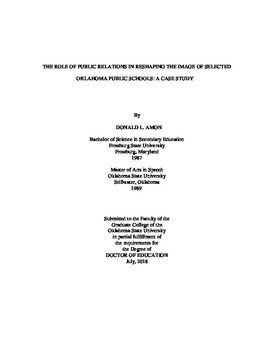| dc.description.abstract | The purpose of this study was to explore the planning and creating of communication relationships between public schools and their respective publics to bolster perceptions of public education. To learn about local school systems, the public actively seeks information about these stories from media outlets such as newspapers, television stations, and social media (O'Reilley & Matt, 2013; Trump, 2012). School administrators must prepare effective communications to combat the incorrect information and to champion accurate information as a means to nourish positive perceptions of education. In the absence of the truth, people fill in the gaps and begin to contrive scenarios from which the data emerges (O'Reilley & Matt, 2013). Therefore, it is vital that effective communication exist between public schools and lay publics (Ediger, 2001). School administrators have a variety of tools available to them in order to effectively communicate with their various publics. Using these tools, school administrators can create a path to achieve excellence in communications with their respective publics. The research questions ask what is being done to communicate with the community and how is the communication received. The questions were answered by 29 participants in 4 schools of varying sizes from small (less than 200 students) to large (more than a 1000 students). Using Grunig's Excellence Theory, which shows the importance of public relations to the organization and how the organization relates to their stakeholders (Grunig, 2008), and the four models of public relations: Press Agent, Public Information, Two-Way Asymmetrical and Two-Way Symmetrical, the research questions were answered. Findings from this study indicate that schools engage with their publics advocating for both local and broad public education. The messages are perceived positively by the stakeholders. The superintendent's role in creating or managing public relations trickles down to the staff. One-on-one communication is the best form of communication, but using a variety of methods available to the school reaches more stakeholders. Based on the research it is important for schools to engage in accurate, timely, and consistent communication with their stakeholders to create a mutual trust between the school and the stakeholders. | |
